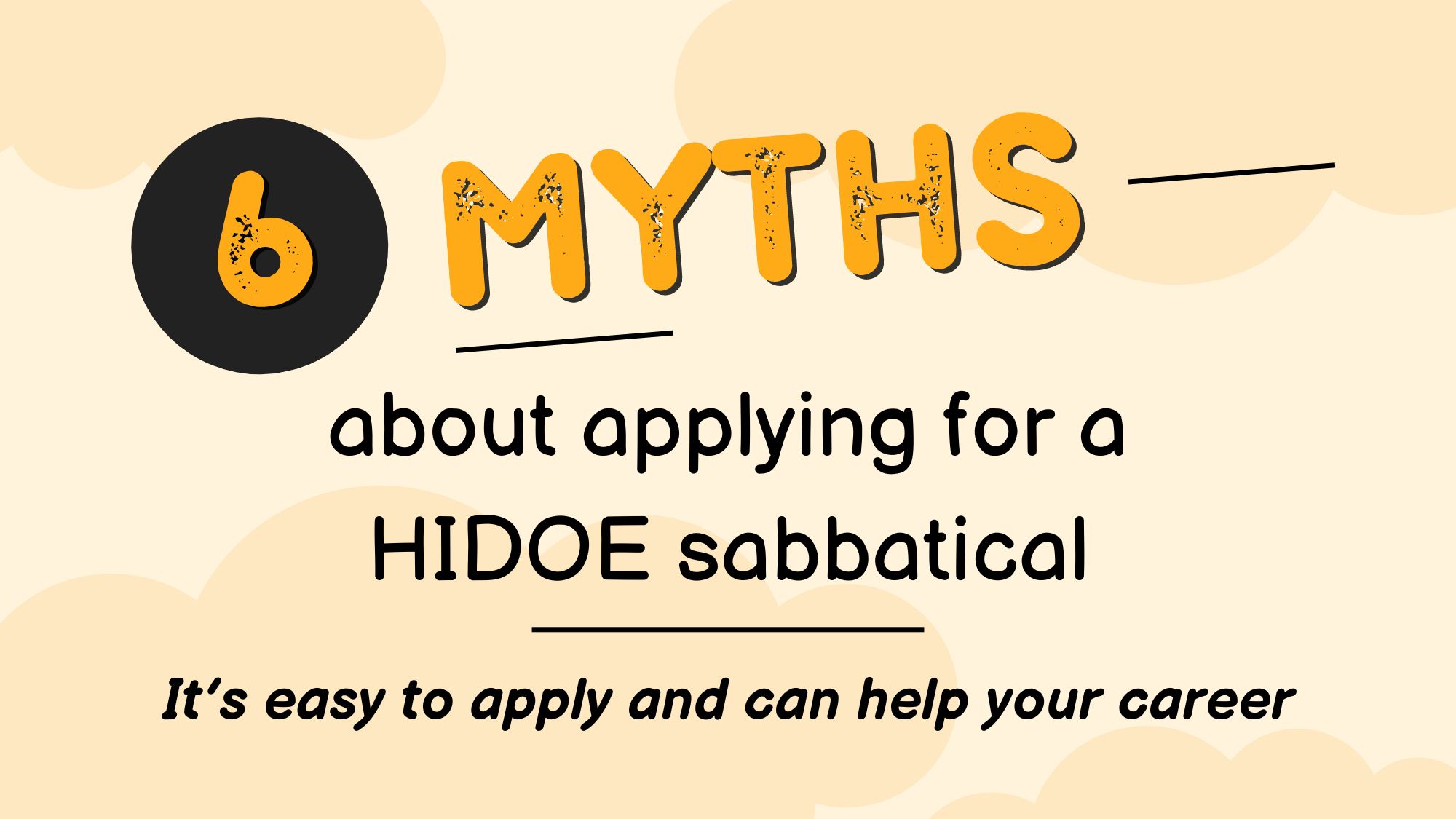It’s easy to apply and can help your career
Posted: December 14, 2023
Author Lisa Thompson (formerly Morrison), the student activities coordinator at Maui’s Kūlanihākoʻi High and Hawaiʻi State Teachers Association secretary-treasurer, took a semester-long sabbatical in 2019 and calls it “one of the best experiences of my career.”
The deadline to apply for a Hawaiʻi State Department of Education sabbatical for the 2024–25 school year is Friday, Jan. 5, 2024. This program is open to any HIDOE teacher in Bargaining Unit 05, but many teachers may not realize how easy it is to apply and how beneficial it can be to your professional and personal development. I’d like to dispel some of the myths I’ve heard about taking a sabbatical.
Myth #1: A sabbatical is unaffordable.
A sabbatical leave may be taken for one full school year at half pay or one semester at full pay. If money is a concern, then a semester-long sabbatical will be the choice for you because you would receive full pay, including any union-negotiated raises, you are entitled to when working. In addition, if you have a second job or need to supplement your income, you can continue other work that is flexible around your sabbatical studies. Also, you may want to consider ways you spend money now that might not be needed during sabbatical – like commuting costs and school lunch.
Myth #2: A sabbatical requires coursework.
Sabbatical proposals are ranked by certain criteria so yes, the rigor of your proposed plan and your years of service can put you higher on the priority list for approval, but you are not required to take classes or pursue a degree. In fact, when I was approved for a sabbatical in 2019, I had only seven years of service and I pitched a plan to visit schools and learn about their best practices around positive behavioral supports and interventions. At the end of the sabbatical, I wrote a report about what I learned from my experience, and my administrator signed off on the paperwork.
Myth #3: A sabbatical would take me away from my school, which can’t do without me.
You are no doubt a valuable asset to your school. There is no replacement for you, but the teacher and substitute shortage we are experiencing will not end soon, and it isn’t your fault. You’re not a bad teacher or less of a professional for taking care of yourself. Just like when roads need to be closed in order to be repaved, sometimes some momentary pain is worth the reward to come afterward. A sabbatical can help you to rejuvenate and improve your practice, which will be a win for your school and your students, who will benefit from the new knowledge and experience that you’ll bring to your work.
Myth #4: A sabbatical would take me away from my family.
The very personal choice you make about how to structure your time on sabbatical is yours. Suddenly, you dictate your day instead of the employer. I found that I was more enabled to attend my children’s school activities because I could be more flexible with my schedule during my sabbatical. In fact, I was invited to be the Teacher for Career Day at my son’s school, and I was treated like a celebrity!

Thompson attended her son Miles’ school Career Day during her sabbatical in 2019.
Myth #5: A sabbatical would cause me to lose my benefits and up to a year of service.
While on sabbatical, you earn service credit toward retirement. You also retain health and other benefits. The only benefit you do not accrue is your 18 days of sick leave and vacation leave for 12-month teachers. If you do a semester-long sabbatical, you accrue nine days of sick leave (six of which can be converted to personal leave) on your first day reporting to school.
Myth #6: My principal decides if I can take a sabbatical.
Your principal signs the sabbatical paperwork to submit to the complex area superintendent, but your principal is not the one who evaluates your sabbatical plan using the department’s criteria. As long as your sabbatical proposal relates to your position or to development that could allow you to apply for a different position within HIDOE, your principal’s part is simply to acknowledge that with a signature. If you experience difficulty with your principal in this regard, HSTA is here to help. Submit a contact form through our website.
And, a couple of hard truths:
Your teaching line could be changed in your absence. In some cases, principals can make changes to teaching lines even during the school year for the good of the educational program. No teacher has a right to a specific line assignment from year to year and a sabbatical doesn’t change that. If you are worried about holding on to your position, you might want to be upfront with your principal about that. You might also want to reevaluate staying at your school if your principal isn’t responsive. You deserve to work at a school where you feel valued in the position you hold and may want to consider applying for a transfer in the upcoming transfer period. In addition, if you are out on sabbatical during the spring, the principal still has an obligation to inform you of your tentative line assignment for the following year and you have the right to pursue a transfer during the transfer period like any other teacher.
You need to be discreet if you want to retain privacy about what you do during your sabbatical. I posted very publicly on social media about my travels and school visits because they were part of my sabbatical plan. You are only expected to work on the topic half of your time, so it’s okay to show that you are getting much-needed relaxation time during your sabbatical. If you don’t want people to know, just don’t make it public.
Please consider taking a sabbatical. It has the potential to improve your life, your professional practice, and the education of the keiki we all serve.

